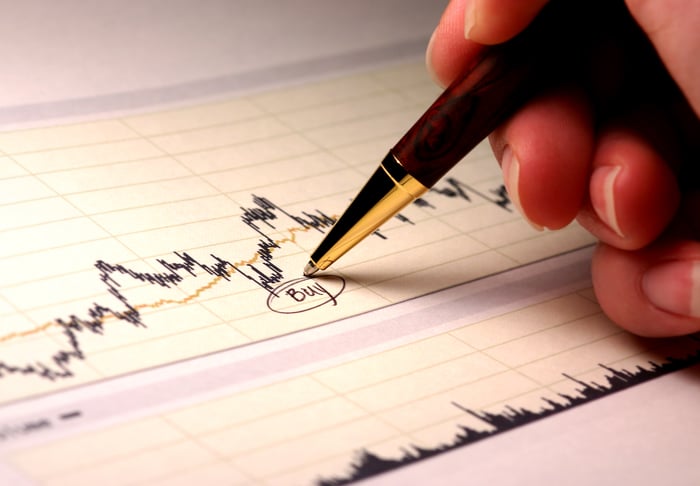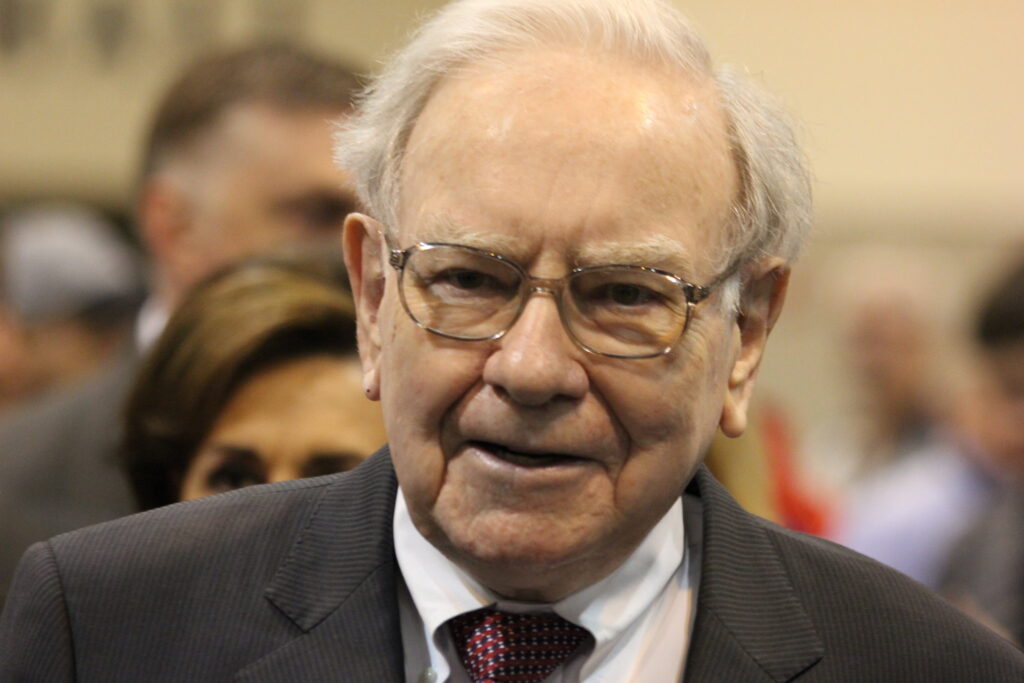[ad_1]
Though the Oracle of Omaha has slashed Berkshire Hathaway’s stake in one of America’s biggest banks, he’s bought shares of another time-tested financial stock in all but one of the last 25 quarters.
For the better part of nearly six decades, Berkshire Hathaway (BRK.A) (BRK.B 0.27%) CEO Warren Buffett has been handily outpacing Wall Street’s benchmark index, the S&P 500. Whereas the S&P 500 has delivered a phenomenal total return, including dividends, of more than 38,000% since the mid-1960s, the aptly named “Oracle of Omaha” has overseen a return of greater than 5,500,000% in Berkshire’s Class A shares (BRK.A) over the same timeline.
Buffett’s outstanding returns and investing prowess are what have made him one of the most-followed money managers on Wall Street.

Berkshire Hathaway CEO Warren Buffett. Image source: The Motley Fool.
Thanks to a couple of required filings with the Securities and Exchange Commission (SEC), including Form 13Fs, Form 4s, and Berkshire Hathaway’s quarterly operating results, it’s fairly easy for everyday investors to ride Buffett’s coattails. A 13F provides investors with a clear snapshot of which stocks Wall Street’s most successful money managers (including Buffett) purchased and sold in the latest quarter.
Based on these filings, we’ve learned that Warren Buffett and his top investment aides, Ted Weschler and Todd Combs, have been very selective buyers in recent years. More specifically, Berkshire’s brightest minds have sold $166 billion more in stocks than they’ve purchased over eight quarters (Oct. 1, 2022 through Sept. 30, 2024).
While this selling activity has been readily apparent of late in a few of Berkshire’s top holdings, there is one financial colossus that Buffett hasn’t been afraid to pile into.
The Oracle of Omaha has dumped more than a quarter of Berkshire’s stake in BofA since mid-July
Though no holding in Berkshire’s 43-stock, $312 billion portfolio has been sold down more noticeably in 2024 than Apple, it’s the recent and persistent selling activity in Bank of America (BAC -0.14%) that’s rightly raising eyebrows on Wall Street.
When Berkshire Hathaway holds a greater than 10% stake in a public company, it’s required to file Form 4 with the SEC within two business days of each buy or sale transaction. Since July 17, Berkshire Hathaway has filed 16 separate Form 4s concerning Bank of America. Over this stretch, more than 266 million shares of BofA have been sold, totaling $10.52 billion and accounting for roughly 26% of Berkshire’s stake, as of the end of June.
Although Warren Buffett is a fan of holding stocks for extended periods, his comments during Berkshire’s annual shareholder meeting in May regarding corporate taxation suggest a possibility that this recent selling in BofA is benign. The Oracle of Omaha noted that he expects the corporate tax rate to eventually rise. Therefore, locking in some of Berkshire’s largest unrealized gains now could, ultimately, save the company money in the long run.
Then again, there are viable reasons to believe Buffett’s selling spree in Bank of America stock is more worrisome than meets the eye.
It’s possible this selling is stock specific. Among money-center banks, BofA is the most sensitive to changes in interest rates. When the Federal Reserve hiked the federal funds rate by 525 basis points between March 2022 and July 2023, it provided an interest income windfall for Bank of America. But with the nation’s central bank recently kicking off a rate-easing cycle, BofA’s operating results might disproportionately suffer as interest rates fall.
What’s potentially more concerning is if Buffett made this decision to dump $10.5 billion worth of Bank of America stock because of a historically pricey stock market. Buffett is a time-tested value investor and an opportunist who pounces on price dislocations. At the moment, value is very difficult to find.
As of the closing bell on Oct.30, the S&P 500 Shiller price-to-earnings (P/E) ratio, which is also referred to as the cyclically adjusted price-to-earnings ratio (CAPE ratio), stood north of 37, which is more than double its nearly 154-year average. It also represents the third-highest reading during a continuous bull market in history.
The actions of Warren Buffett and his investing team appear to foreshadow trouble for Wall Street. Yet in spite of the potential for a meaningful downturn in equities, there is one stock Warren Buffett can’t stop buying.

Image source: Getty Images.
Warren Buffett has put almost $78 billion to work in his favorite financial stock
While Form 13Fs have spilled the beans on some steady purchasing activity in integrated oil and gas giant Occidental Petroleum and Wall Street’s most-anticipated reverse stock split of 2024, Sirius XM Holdings, nothing holds a candle to the nearly $78 billion Buffett has spent buying shares of his favorite financial stock since the midpoint of 2018.
Perhaps the most noteworthy aspect of this buying activity is that you’ll see no trace of it on Berkshire Hathaway’s Form 13Fs, nor among its occasional Form 4 filings. Rather, the only evidence of this big-time buying is found in Berkshire’s quarterly operating results. In the final section of the company’s operating results, just prior to the executive certifications, you’ll find to-the-dollar details of Warren Buffett’s favorite stock to buy… which happens to be shares of his own company.
Repurchasing shares of Berkshire Hathaway stock hasn’t always been easy. Prior to the midpoint of July 2018, Berkshire’s chief was only allowed to buy back his company’s stock if shares fell to or below 120% of book value (based on the most recent quarter). At no point did Berkshire’s shares fall below this line-in-the-sand threshold, which meant not one penny was put to work via buybacks.
Things changed in a big way on July 17, 2018. On this date, Berkshire’s board amended how buybacks take place in order to allow Warren Buffett and then right-hand man Charlie Munger, who passed away last November, to get off the proverbial bench.
Under these new rules, share repurchases can continue with no end date or ceiling as long as Berkshire Hathaway has at least $30 billion in cumulative cash, cash equivalents, and U.S. Treasuries on its balance sheet, and Warren Buffett views his company’s shares as intrinsically cheap. This last point is fairly subjective, which gives Berkshire’s chief a lot of flexibility when putting his company’s cash to work with buybacks.
During the June-ended quarter, Buffett oversaw the repurchase of $345 million worth of his company’s stock, which increased his total purchases to nearly $78 billion since July 2018. However, for the first time in 25 quarters, the Oracle of Omaha didn’t purchase his own company’s stock in the latest quarter (ended Sept. 30). Neither he nor his team have spent anywhere close to $78 billion on any stock currently in Berkshire’s $312 billion portfolio.
Since Berkshire doesn’t pay a dividend, share repurchases are a logical way for Buffett and his company’s board to grow shareholder value and incent long-term investing. By steadily reducing his company’s outstanding share count, Buffett is incrementally increasing the ownership stake of shareholders.
Furthermore, reducing Berkshire’s share count would be expected to have a positive impact on its earnings per share (EPS). Excluding unrealized investment gains/losses, Buffett’s company has a lengthy track record of increasing its operating income. Consistently buying back shares of his favorite financial stock should make it more fundamentally attractive to investors.
[ad_2]
Source link

